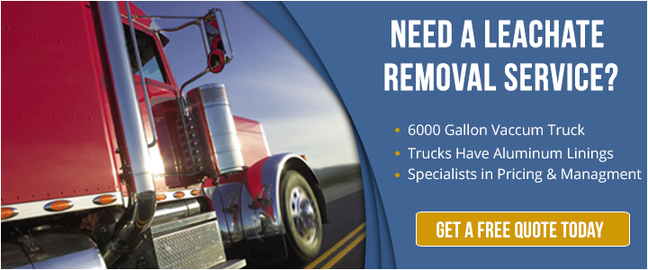Nothing is more critical to our natural resources than our water supply. Protection from contaminates, no matter what source, is good for all of us. Leachate is one of the most common types of liquid that can seep into our water supply and contaminate it.
What is Leachate?
Leachate is a liquid that drains or ‘leaches’ from landfills. It usually comes from rain, snow melts or from the waste itself. Its composition can vary widely depending on the age of the landfill and the type of waste that it contains. It usually contains both dissolved and suspended materials.
According to the U.S. Geological Survey (USGS), "Landfills are the final repository for a heterogeneous mixture of liquid and solid waste from residential, industrial, and commercial sources, and thus, have the potential to produce leachate—a liquid waste product that consists of a diverse mixture of chemicals as precipitation or applied water moves through the waste. Landfills are often not the final repository for leachate which can be discharged to surface waters following onsite or offsite wastewater treatment."
How Does Leachate Contaminate the Water Supply?
When waste is placed in landfills, over time the waste decomposes and sweats. This liquid, leachate, is hazardous and must be collected for disposal. Companies who manage landfills have a specialized draining system in place that collects this leachate. The fluid is usually collected into tubes that transport it to special containers. Hazardous waste transporters then collect the waste for proper disposal.
Prevention of hazardous waste contamination is much more cost effective than cleanup. Doing it right the first time will save costly fixes that affect the bottom line, and more importantly, may solve the contamination problem.
Landfill Cross Section

The leachate from Municipal Solid waste landfills is a highly concentrated "chemical soup", so concentrated that small amounts of leachate can pollute large amounts of groundwater, leaving it unsuitable for domestic water use.
The risk of groundwater contamination by any leachate that is not caught by collection systems is determined by the following factors:
- Concentration and toxicity of contaminants
- Permeability and type of the geologic strata
- The direction of groundwater flow
Areas near landfills have a greater possibility of groundwater contamination because of the potential pollution source of leachate originating from the nearby site. Such contamination of groundwater resources poses a substantial risk to local resource users and to the natural environment.
Groundwater Flow is Important
Groundwater moves slowly and continuously through the open spaces in soil and rock. If a landfill contaminates groundwater, a plume of contamination will occur. Wells in that plume will be contaminated, but other wells, even those close to the landfill, may be unaffected if they are not in the plume.
Long drought years and occasional heavy wet spells lead to accelerated dispersion of leachate in the surrounding areas causing surface and subsurface contamination. The groundwater quality as well as leachate pollution potential is improved during post-monsoon plausibly due to heavy rainwater recharge.
In California, sustained drought conditions could lead to conditions where leachate pollution is compounded by arid soil.
Health Impacts
In evaluating the human health impact of leachate contamination of groundwater, the pathway considered  has been direct ingestion of contaminated water.
has been direct ingestion of contaminated water.
Fecal contamination has been detected in leachate samples. Bacterial contamination is generally easy to deal with, by boiling or disinfecting (chlorinating) the groundwater. But again, adding costs that are unnecessary if prevention practices are followed.
Other contaminates, including heavy metals and inorganic compounds such as: calcium, magnesium, sodium, potassium, ammonium, iron, sulfate and bicarbonate are not so easy to deal with, and in fact can react with the chlorine used in the disinfection process.
This increases both risk and hazard to the public.
Leachate Disposal from Landfills
The vast majority of managed landfills, like Broadrock Renewables and Western Waste Management already incorporate the latest technological advances in landfill protection. Leachate pipes collect the waste liquid that has seeped through to the base of the landfill. These pipes then transport the contaminated liquid into special containers, which are then collected by a hazardous waste transportation company for proper disposal.
Protection
Proper lining of landfills is crucial to keep our groundwater safe.  Tests in the middle east have shown that shredding solid waste material has helped the decomposition process, increasing the rate of biological degradation. Also, allowing the waste to compost for a week before covering with soil can improve results.
Tests in the middle east have shown that shredding solid waste material has helped the decomposition process, increasing the rate of biological degradation. Also, allowing the waste to compost for a week before covering with soil can improve results.
Lining landfills, to prevent leakage is an important step, as is continued monitoring. Proper hazardous waste disposal must be employed if the entire contamination process is going to be successful.
Protect our water supply and protect the public's health, it's good for all of us.


Comment